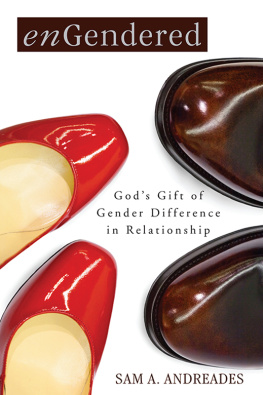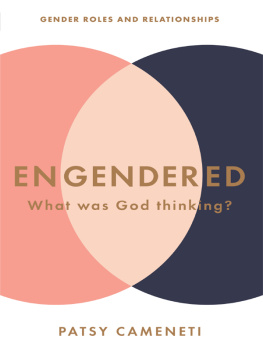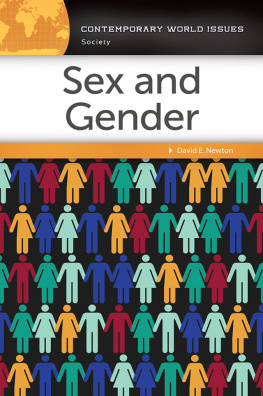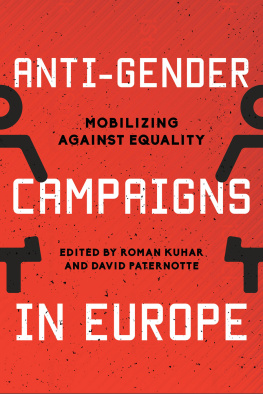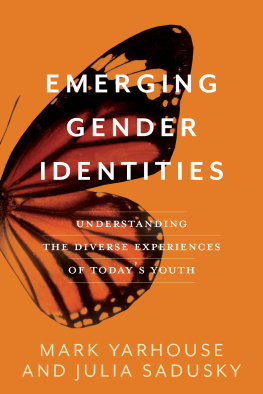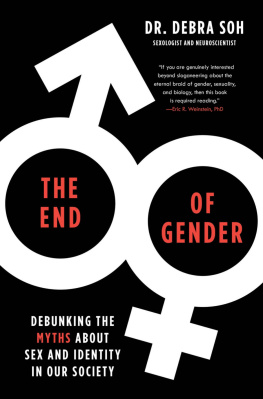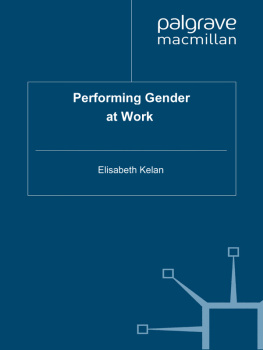


Gods Gift of
Gender Difference
in Relationship
SAM A. ANDREADES

enGendered: Gods Gift of Gender Difference in Relationship
2015 by Sam A. Andreades
First edition published by
Weaver Book Company
1190 Summerset Dr.
Wooster, OH 44691
Visit us at weaverbookcompany.com
All rights reserved. No part of this book may be reproduced, stored in a retrieval system, or transmitted in any form or by any meanselectronic, mechanical, photocopy, recording or otherwisewithout written permission of the publisher, except for brief quotations in printed reviews.
DISCLAIMER: Personal names used in this book have been changed to protect privacy.
Unless otherwise indicated, all Scripture quotations are from the ESV Bible (The Holy Bible, English Standard Version), copyright 2001 by Crossway, a publishing ministry of Good News Publishers. Used by permission. All rights reserved.
Scripture quotations marked (NIV) are taken from the Holy Bible, New International Version, NIV. Copyright 1973, 1978, 1984, 2011 by Biblica, Inc. Used by permission of Zondervan. All rights reserved worldwide. www.zondervan.com. The NIV and New International Version are trademarks registered in the United States Patent and Trademark Office by Biblica, Inc.
Scripture quotations marked (RSV) are taken from the Revised Standard Version of the Bible, copyright 1946, 1952, and 1971 National Council of the Churches of Christ in the United States of America. Used by permission. All rights reserved.
Italics in Scripture quotations indicate emphasis added by the author. Verse numbers appear in some Scripture quotations when the author refers to or comments on specific verses. Verses prefaced by literally or the like are the authors translation from the original language.
Cover: Frank Gutbrod
Interior design and typesetting: Frank Gutbrod
Editing: Paul J. Brinkerhoff
ISBN: 978-1-941337-11-0
ISBN (e-book): 978-1-941337-31-8
Library of Congress Cataloging-in-Publication Data
Andreades, Sam A., 1962
enGendered : Gods gift of gender difference in relationship / Sam A. Andreades. -- First Edition.
pages cm
Includes bibliographical references and index.
ISBN 978-1-941337-11-0 (pbk.) -- ISBN 978-1-941337-31-8 (e-book)
1. Man-woman relationships--Religious aspects--Christianity. 2. Sex role--Religious aspects--Christianity. 3. Intimacy (Psychology) --Religious aspects--Christianity. 4. Homosexuality--Religious aspects--Christianity.
I. Title.
BT705.8.A53
2015 230.081--dc23
2014042986
Printed in the United States of America
15 16 17 18 19 / 5 4 3 2 1
Contents
Scenic Overlooks
from the Bible
T his preface is for those readers who like to get down to the brass tacks and know what they are getting themselves into before they start reading. It gives the layout of the book and an explanation of its parts and chapters. Readers who are not in the same hurry may skip this preview and simply discover the trail the author has blazed for you in the pages following.
This book attempts to explain the importance of gender in relationships. It is born of a pastors attempts to help people navigate the current relationship scene in light of biblical truth. In our times the shifting cultural landscape on gender, the normalization of same-sex relationships, and feminist critiques of difference in men and womens roles has yielded increasing numbers of people finding biblical injunctions in the area of gender puzzling, which produces an increasing need among Christians for guidance on close relationships. Praying and preaching, counseling and convincing, failing and succeeding in aiding and arguing have supplied the answers found herein. The pastoral work underlying these answers continued through a doctoral dissertation studying successful Christian marriages of husband and wife where the husband had a history of same-sex attraction.
The book proceeds upon the premise that the issues of homosexuality and whether women and men should behave differently are cut of the same cloth: the role of gender in relationships. The introduction argues the need for a theology of gender, positively expressed, to guide us in these issues, while explaining the authors journey to it.
The book then builds a theology of gender in six propositions through addressing gender questions about close relationships one chapter at a time. Each chapter begins with questions we typically hear on peoples lips today, representing problems the chapter then addresses. Some of the books chapters are introduced by dramatic tellings of Bible narratives illustrating gender in action. These Scenic Overlooks, opening , give vistas of the trail of gendered relationship we are navigating.
), after the first of these biblical imaginings, unfolds the first four propositions:
then explains the first proposition by showing where relationships come from. God has intimacy within His Trinitarian Self and so likewise intends for us to know emotional intimacy with one another and with Him.
The classic though now nonstandard practice of capitalizing pronouns and nouns referring to God, as in the previous sentence, finds particular prominence in , and is employed thereafter. Though perhaps unfamiliar, this convention is used to honor the Giver of the gift of gender, setting Him apart in the writing as a singular Deity deserves. The convention extends to plural pronouns referring to Gods three Persons in community (as in, Let Us make man in Our own Image or God is a community of love inside Themself), phrasing that is itself unfamiliar, but possessing warrant in Gods plural Self within a unity.
elaborates on these four propositions by distinguishing sexual differences (male/female) from gender differences (masculine/feminine).
) explores the fifth proposition, that Gods gift of gender creates asymmetries in our posture and behavior. The gift calls us to specialties for one another. Traversing this ground carries us to resilient definitions of true womanliness and real manhood.
Specifically, takes up the interaction of gender with culture.
The final section, pursues the hints in Scripture of an invitation to ever-greater intimacy.
To help review, supplies a chiasmus or chiasm (a common device in Hebrew narratives) showing the relationship between the narrative elements in the book of Judges, used at several points in this book.
This work is a poor offering, but it is the authors great hope that through it the reader seeking to love well might acquire some inkling of the profound wisdom in what God has created and in what He commands.

Introduction:
Prohibitions Are Not Enough
O kay. I got it but it doesnt help me. I had just finished the Sunday sermon, a careful explication of one of the New Testament passages limiting church eldership to men. Rachel, the perceptive young woman, recently married and faithfully active in our little New York City congregation, was front and center to deliver her heartfelt response to my brilliant teaching. But it was not praise. I did not mind this. I had been a preacher long enough to stop caring much whether people thought I was good and to start caring very much whether what I was saying was actually helping anyone change. Sermon reactions, even negative ones, help me understand my preaching through my listeners ears. But I was still not expecting this.

